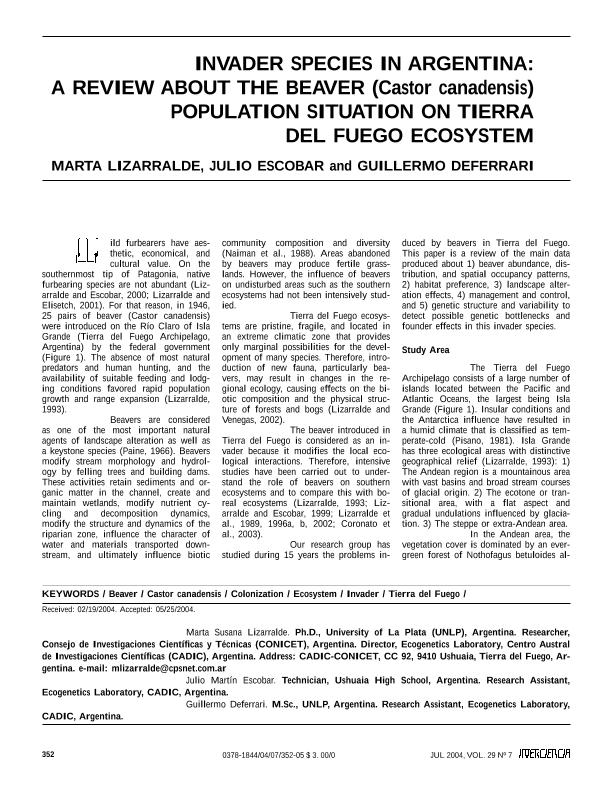Artículo
Invader species of Argentina: A review about beaver (Castor canadensis) population situation on Tierra del Fuego ecosystem
Fecha de publicación:
12/2004
Editorial:
Interciencia
Revista:
Interciencia
ISSN:
0378-1844
Idioma:
Inglés
Tipo de recurso:
Artículo publicado
Clasificación temática:
Resumen
Beavers (Castor canadensis) were introduced on Isla Grande of Tierra del Fuego, Argentina, in 1946. The suitable feeding and lodging sites coupled with the lack of natural predators or competitors favored rapid population growth and range expansion. This paper shows current population status and landscape modifications induced by beaver in these southern ecosystems. Beaver now occur in all streams in the Andean and extra-Andean areas and nearly all aquatic habitats on Isla Grande as well as other Chilean islands of Tierra del Fuego archipelago (70,000 km2). Low-gradient areas on small streams were more densely occupied than those of the slope valleys. Densities were similar to those in the Northern Hemisphere. Extensively colonized habitats showed 0.7 active beaver colonies per km2. Based on their different beaver occupancy patterns and frequency of colony sites, we developed four land capability classes-A, B, C and D-to use in planning and resource management. The highest densities were found in classes C and D -4.7 and 5.6 colony sites per km- indicating that both these areas had the greatest potential for beaver production. Beaver-altered sites had higher levels of organic and inorganic nitrogen suggesting that seasonal hydrological changes could be affecting nitrification and denitrification and also resulting in accumulated organic carbon and phosphorus in the stream channel. Beaver ponds may be considered sources of essential nutrients (P and N) and carbon. Chromosome analysis showed no differences with the North American karyotype. Genetic structure and variability of the beaver population are analyzed.
Palabras clave:
Invader
,
Beaver
,
Tierra del Fuego
Archivos asociados
Licencia
Identificadores
Colecciones
Articulos(CADIC)
Articulos de CENTRO AUSTRAL DE INVESTIGACIONES CIENTIFICAS
Articulos de CENTRO AUSTRAL DE INVESTIGACIONES CIENTIFICAS
Articulos(CCT - LA PLATA)
Articulos de CTRO.CIENTIFICO TECNOL.CONICET - LA PLATA
Articulos de CTRO.CIENTIFICO TECNOL.CONICET - LA PLATA
Citación
Lizarralde, Marta Susana; Escobar, Julio Martin; Deferrari, Guillermo Alejandro; Invader species of Argentina: A review about beaver (Castor canadensis) population situation on Tierra del Fuego ecosystem; Interciencia; Interciencia; 29; 7; 12-2004; 352-356
Compartir




